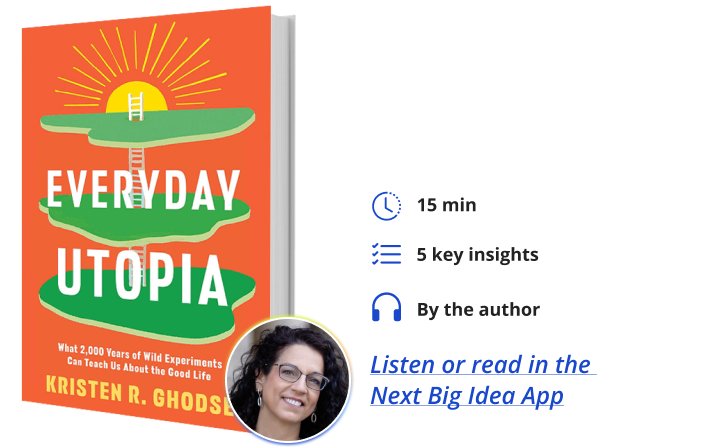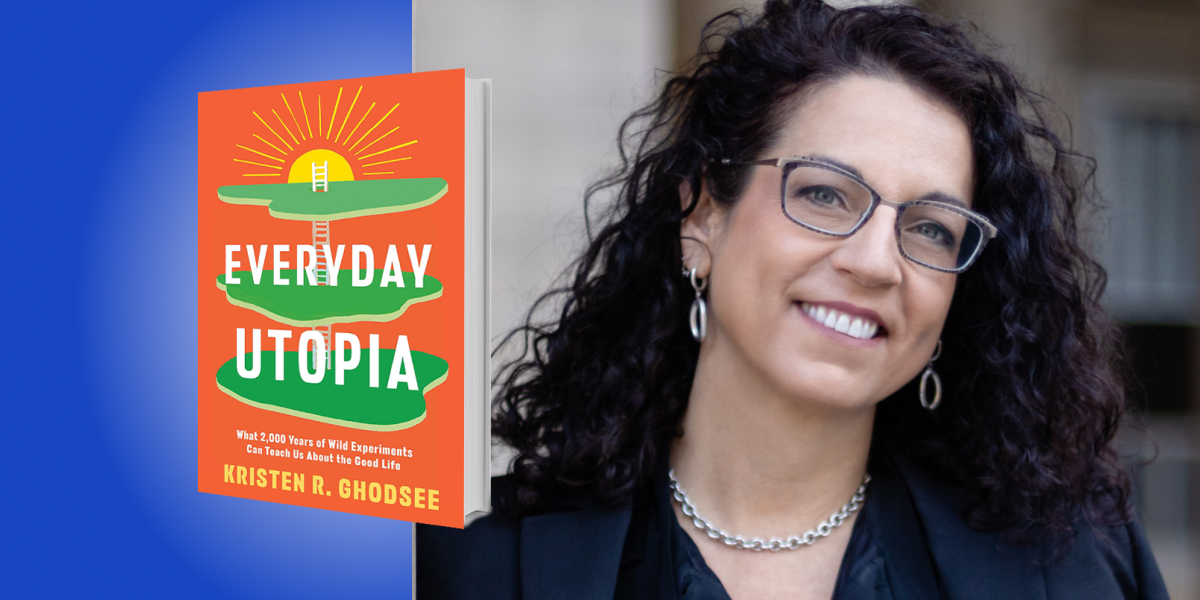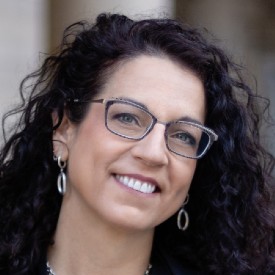Kristen Ghodsee is a professor of Russian and Eastern European Studies at the University of Pennsylvania and the critically acclaimed author of Why Women Have Better Sex Under Socialism: And Other Arguments for Economic Independence, which has been translated into fourteen languages. Her writing has been published in the New York Times, The Washington Post, The New Republic, Le Monde Diplomatique, and Jacobin, among other outlets, and she’s appeared on PBS NewsHour and France 24 as well as on dozens of podcasts, including NPR’s Throughline and New York magazine’s The Cut.
Below, Kristen shares 5 key insights from her new book, Everyday Utopia: What 2,000 Years of Wild Experiments Can Teach Us About the Good Life. Listen to the audio version—read by Kristen herself—in the Next Big Idea App.

1. We value blue-sky thinking in everything except what matters most.
In science, medicine, and the cutthroat world of corporate research and development, our society lauds the advantages of so-called blue-sky thinking. When faced with intractable challenges, leaders will often convene groups of free minds to unleash their imaginations and consider even the most preposterous solutions. The essence of blue-sky thinking is its unboundedness, audacity, and unabashed willingness to stand accused of naiveté and utopianism.
But when it comes to dealing with difficult social problems, we move slow and preserve things. Although growing inequality is sowing division and eroding democracy, and although people are suffering from epidemics of loneliness, meaninglessness, and existential despair, we play it safe. We don’t unleash creativity to rethink the most basic aspects of our day-to-day experiences: where we live, who we love, with whom we share our things, or how we raise our children. If we are to survive and thrive in the twenty-first century, we need to apply blue-sky thinking to our private as well as our public lives.
2. People have sought alternative ways to organize their private lives for over 2500 years.
Ever since the fifth century BC, when Pythagoras and his followers left mainland Greece to set up a colony in what is now Southern Italy, mathematicians, philosophers, theologians, dreamers, spiritual seekers, visionaries, and revolutionaries have understood that the way we organize our domestic sphere often upholds the prevailing political and economic norms in our society.
In The Republic, the ancient Greek philosopher Plato dedicated much of Book V to reimaging how male and female leaders and warriors of his perfect city of Kallipolis would live together, share their things, and raise children to build a more harmonious society. In 530 AD, Saint Benedict of Nursia wrote a specific set of rules for how groups of monks could live communally as a way of retreating from the crass concerns of the material world. About a thousand years later, Sir Thomas More wrote Utopia in 1516. Here, he described a more perfect society where collective ownership and the cooperative rearing of children affords the Utopians a prosperous, stable, and joyful society where universal literacy reigned and people elected their leaders, an outlandishly radical idea which contributed to his martyrdom at the hands of Henry VIII.
“The way we organize our domestic sphere often upholds the prevailing political and economic norms in our society.”
In the late 19th and early 20th centuries, the aristocrat-turned-revolutionary, Alexandra Kollontai, warned her male colleagues in the world’s first worker’s state that their attempt to reimagine society would fail if they did not also rethink the traditional Russian family. These dreamers, and many more throughout the millennia, have understood that changes in society require new and different ways of living together and defining the family.
3. Today’s housing limits our ability to live happier, more connected, and sustainable lives.
Architects have long understood that our homes both reflect and shape our ideas of family relations. The physical design of the dwellings we inhabit promotes certain social norms. In the standard single-family abode, we are each tasked with cooking and cleaning up in our kitchens, doing laundry in our own washing machines that sit unused most of the week, or mowing our little pieces of lawn—even though there are huge economies of scale that could be realized. From an environmental perspective, heating and cooling individual homes is remarkably wasteful, as is equipping them with large appliances designed to be obsolete in ten years, which will then pile up in landfills.
Furthermore, the American National Institute on Aging claims that the health risks of prolonged isolation are the same as smoking fifteen cigarettes a day and that extended periods of loneliness can shorten a person’s life span by as much as 15 years. At the same time, we know from recent empirical studies, conducted everywhere from Norway to Japan, that more communal forms of dwelling can make our lives less lonely, less harried, and less deleterious to the environment. The Danish experience with co-housing and more recent international experiments with co-living try to optimize the balance between our need for privacy with our inherent desire for companionship.
“More communal forms of dwelling can make our lives less lonely, less harried, and less deleterious to the environment.”
We live the way we do because we are still stuck with the architecture of the last century. Most current housing options reflect a domestic ideal that no longer makes social, psychological, or environmental sense. We’re overdue for a hardware update.
4. Romantic relationships should not be the only container for parenthood.
If we examine the vast diversity of human family forms across cultures and throughout history, we see that humanity has embraced different mating and childrearing practices depending on specific geographic, climatic, social, political, and economic circumstances. We know from research in fields like evolutionary anthropology and biology that humans have survived and thrived by adapting their family forms to suit a wide variety of conditions, such that there is no one “natural” way of organizing the smallest unit of our societies.
The isolation and loneliness precipitated by COVID-19, as well as the rush to form “pandemic pods” to help raise and educate children, revealed the shortcomings of the traditional nuclear family where two parents raise their kids in a single-family home filled to the rafters with their own stuff. Our mating practices and our childrearing practices are separable. We sometimes raise our children exclusively with our romantic partners, but there is no reason that we have to.
Many cultures still live multi-generationally, allowing parents and grandparents to share the responsibilities of parenthood. Others live in extended households which include aunts, uncles, older siblings, and cousins that all contribute to the work of childrearing. Beyond kinship relations, some people decide to become “platonic parents” where friends, colleagues, or companions bring children into their lives in the absence of a romantic attachment or consanguine relations. In other cases, romantic couples might legally add a third or fourth co-parent to formalize an important relationship to the child; this can be the egg or sperm donor in the case of same-sex couples, the surrogate mother, or an asexual family friend who wants to experience the joys of parenthood independent of romantic attachment. Divorced, abandoned, or widowed parents might also expand their definition of family to share their emotional, attentional, and financial resources for the sake of their children.
“Our mating practices and our childrearing practices are separable.”
This isn’t to say that people won’t still have children with the people they feel romantically attached to, but merely to recognize that romantic attachments often fade faster than our responsibilities as parents. High rates of divorce create instability that is deleterious to children’s welfare. The answer is not to “strengthen marriage” or trap people in unhealthy or unsatisfying relationships by making it more difficult to divorce, but rather to separate our romances from our roles as parents. We can expand our definition of “family” to include a wider constellation of relationships.
5. Children thrive in environments full of loving adults.
It not only takes a village to raise a child, but it’s also healthier for children to be raised by multiple caring adults who are invested in their welfare. Human beings were cooperative breeders before bi-parental care became a social norm in the West, and we have good psychological evidence to show that the cognitive development of babies is faster and more robust when they can form secure attachments to both kin and non-kin caregivers.
Some U.S. states already allow for a child to have three or more legal guardians, and these arrangements will only continue to proliferate. Legally recognizing the rights of more than two parents protects children from being placed in foster care if one or both biological parents leaves, dies, falls ill physically or mentally, or is otherwise incapable of caring for a child. Too many loving grandparents, godparents, stepparents, and others have been deprived of their de facto parental roles by courts that refuse to consider the importance of non-biological parents in the lives of children.
Perhaps more important, as increasing numbers of Millennials and members of Generation Z decide to forgo childbearing–in protest against climate change, the housing crisis, or the growing precarity of their financial futures in a brutal gig economy, a growing acceptance of multi-parenting might offer different opportunities for them to share in the joys of parenthood. Rather than struggling to balance breadwinning and caregiving between two people, young people may decide to spread all of the physical, financial, mental, and emotional requirements of raising happy and healthy children among a greater number of committed adults. Not only will children benefit from more stability and continuity, but strained parents will feel less isolated and more supported.
By learning from the many social dreamers who came before us, and with a little creativity and blue-sky thinking, we can find new ways to define the family to help us live more loving, caring, and connected lives.
To listen to the audio version read by author Kristen Ghodsee, download the Next Big Idea App today:






























